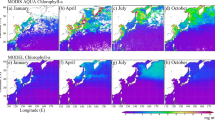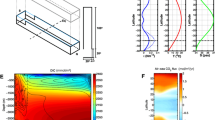Abstract
Inorganic carbon in the ocean is modelled as a passive tracer advected by a three-dimensional current field computed from a dynamical global ocean circulation model. The carbon exchange between the ocean and atmosphere is determined directly from the (temperature-dependent) chemical interaction rates in the mixed layer, using a standard CO2 flux relation at the air-sea interface. The carbon cycle is closed by coupling the ocean to a one-layer, horizontally diffusive atmosphere. Biological sources and sinks are not included. In this form the ocean carbon model contains essentially no free tuning parameters. The model may be regarded as a reference for interpreting numerical experiments with extended versions of the model including biological processes in the ocean (Bacastow R and Maier-Reimer E in prep.) and on land (Esser G et al in prep.). Qualitatively, the model reproduces the principal features of the observed CO2 distribution bution in the surface ocean. However, the amplitudes of surface pCO2 are underestimated in upwelling regions by a factor of the order of 1.5 due to the missing biological pump. The model without biota may, nevertheless, be applied to compute the storage capacity of the ocean to first order for anthropogenic CO2 emissions. In the linear regime, the response of the model may be represented by an impulse response function which can be approximated by a superposition of exponentials with different amplitudes and time constants. This provides a simple reference for comparison with box models. The largest-amplitude (∼0.35) exponential has a time constant of 300 years. The effective storage capacity of the oceans is strongly dependent on the time history of the anthropogenic input, as found also in earlier box model studies.
Similar content being viewed by others
References
Bacastow R, Björkström A (1981) Comparison of ocean models for the carbon cycle. In: Bolin B (ed) Carbon cycle modelling, SCOPE 16:29–80. John Wiley and Sons, New York
Bainbridge A GEOSECS ATLANTIC EXPEDITION, Sections and profiles. Washington
Berger WH, Keir RS (1984) Glacial-holocene changes in atmospheric CO2 and the deep-sea record. In: Hansen JE, Takahashi T (eds) Climate processes and climate sensitivity. AGU, Washington DC, 337–351.
Bermer WI, Stauffer B, Oeschger H (1979) Past atmospheric composition and climate. Gas parameters measured on ice cores. Nature 275:53–55
Björkström A (1979) A model of CO2 interaction between atmosphere, oceans and land biota. In: Bolin B, Degens ET, Kempe S, Ketner P (eds) The global carbon cycle.SCOPE 13: 403–457. John Wiley and Sons, New York
Bojkov RD (ed) (1983) Report of the WMO (CAS) meeting of experts of the CO2 concentrations from pre-industrial times to IGY WCP-53, WMO, Geneva
Bolin B (1975) A critical appraisal of models for the carbon cycle. In: The physical basis of climate and climate modeling, GARP Publ. No 16: 225–235
Bolin B, Eriksson E (1959) Changes in the carbon dioxide content of the atmosphere and sea due to fossil fuel combustion. In. The Rossby Memorial Volume, New York, 130–142
Bolin B, Degens ET, Kempe S, Ketner P (eds) (1979) The global carbon cycle,SCOPE 16, John Wiley and Sons, New York
Broecker WS (1974) Chemical oceanography. 214pp, Harcourt Brace Jovanovich, NY
Broecker WS, Takahashi T (1984) Is there a tie between atmospheric CO2-content and ocean circulation? In: Hansen JE, Takahashi T (eds) Climate processes and climate sensitivity. Geophys Monogr Ser 29:314–326. AGU, Washington DC
Brutsaert W, Jirka GH (eds) (1984) Gas transfer at water surfaces. 639pp, Reidel Publ, Dordrecht Boston Lancaster
Bryan K (1969) Climate and the ocean circulation. III. The ocean model. Mon Wea Rev 97:806–834
Bryan K (1979) Models of the world ocean. Dyn Atmosph Oceans 3:327–338
Bryan K, Lewis LJ (1979) A water mass model of the world ocean. J Geophys Res 84:2503–2517
Bryan K, Spelman MT (1986) The oceanic response to a CO2 induced warming. J Geophys Res 90,C6:11679–11688
Craig H, Broecker WS, Spencer D (1981) GEOSECS PACIFIC EXPEDITION, Sections and profiles, Washington
Delmas RJ, Ascencio J-M, Legrand M (1980) Polar ice evidence that atmospheric CO2 29,000 yr. BP was 50% of the present. Nature 284:155–157
Edmonds JA, Reilly T, Trabalka TR, Reichle D-E (1984) An analysis of possible future atmospheric retention of fossil fuel CO2. Dept Energy, DOE/OR21400-1
Hasselmann K (1982) An ocean model for climate variability studies. Progr Oceanogr 11:69–92
Hellermann S (1967) An updated estimate of the wind stress on the world ocean. Mon Weather Rev 95:593–606
Houghton RA, Hobbie JE, Melillo JM, Moore B, Peterson BJ, Shaver GR, Woodwell GM (1984) Changes in the carbon content of terrestrial biota and soils between 1860 and 1980: A net release of CO2 to the atmosphere. Ecol Monogr 53:235–262
KeelingCD (1973) The carbon dioxide cycle: reservior models to depict the exchange of atmospheric carbon dioxide with the oceans and land plants. In:Rasool SI () Chemistry of the lower atmosphere.Plenum Press,NY 251–328
Keeling CD, Bacastow RB, Whorf TP (1982) Measurements of the concentration of carbon dioxide at Mauna Loa Observatory, Hawaii. In: Clark WC (ed) Carbon Dioxide Review, 377–385
Killough GG, Emanuel WR (1981) A comparison of several models of carbon turnover in the ocean with respect to their distributions of transit time and age, and responses to atmospheric CO2 and14C. Tellus 33:274–290
Lal D, Suess HE (1983) Some comments on the exchange of CO2 across the air-sea interface. J Geophys Res 88, C6:3643–3646
Laurmann JA, Rotty RM (1983) Exponential growth and atmospheric carbon dioxide. J Geophys Res 88, C2:1295–1299
Levitus S, Oort AH (1977) Global analysis of oceanographic data. Bull Am Met Soc 58:1270–1284
Maier-Reimer E (1984) Towards a global ocean carbon model. Progress in Biometeorology 3:295–310
Maier-Reimer E, Hasselmann K, Olbers D, Willebrand J (1982) An ocean circulation model for climate studies. Techn. Report, Max-Planck-Institut für Meteorologie, Hamburg
Millero FJ (1978) The thermodynamics of the carbonate system in sea water. Geoch et Cosmoch Acta 43:1651–1661
National Academy of Sciences (1982) Carbon dioxide and climate: a second assessment.Report of the CO2/Climate Review Panel, National Research Council, Acad Press, Washington DC
Neftel A, Moor E, Oeschger H, Stauffer B (1985) Evidence from polar ice cores for the increase in atmospheric CO2 in the past two centuries. Nature 315:45–47
Neftel A, Oeschger H, Schwander J, Stanffer B (1983) Carbon dioxide concentration in bubbles of natural cold ice. J Phys Chem 87:4116–4120
Nydal R, Lövseth K (1983) Tracing bomb14C in the atmosphere 1962–1980. J Geophys Res 88, C6:3621–3642
Oeschger H, Siegenthaler U, Schotterer U, Gugelmann A (1975) A box diffusion model to study the carbon dioxide exchange in nature. Tellus 27:168–192
Östlund HG, Stuiver M (1980) GEOSECS Pacific radiocarbon. Radiocarbon 22:25–53
Östlund HG, Dorsey HG, Brescher R (1976) GEOSECS Atlantic radiocarbon and tritium results (Miami). Tritium Laboratory Data report no. 5, Rosenstiel School of Marine and Atmospheric Science, Univ. of Miami
Peng TH, Broecker WS, Freyer HD, Trumbore S (1983) A deconvolution of the tree-ring based ε13C record. J Geophys Res 88, C6:3609–3620
Revelle R, Suess HE (1957) Carbon dioxide exchange between atmosphere and ocean and the question of an increase of atmospheric CO2 during the past decades. Tellus 9:18–27
Riley JP, Skirrow G (1965) Chemical oceanography, Vol. I, 712 pp, Vol. II, 508 pp. Academic Press, London NY
Rotty RM (1981) Data for global CO2 production from fossil fuels and cement. In: Bolin (ed) Carbon cycle modelling, SCOPE 16:121–127. John Wiley and Sons, New York
Rotty RM (1983) Distribution of and changes in industrial carbon dioxide production. J Geophys Res 88, C2:1301–1308
Rotty RM (1986) A look at 1983 CO2 emissions from fossil fuels (draft manuscript)
Siegenthaler U (1983) Uptake of excess CO2 by an outcropdiffusion model of the ocean. J Geophys Res 88, C6:3599–3608
Siegenthaler U, Oeschger H (1978) Predicting future atmospheric carbon dioxide levels. Science 199: 388–395
Stuiver M, Östlund HG (1980) GEOSECS Atlantic radiocarbon. Radiocarbon 22:1–24
Sundquist ET (1985) Geological perspectives of carbon dioxide and the carbon cycle, 5–59. In: Sundquist ET, Broecker WS (eds) The carbon cycle and atmospheric CO2: natural variations Archean to present. Am Geophys Union, Washington DC, 627 pp
Sundquist ET, Broecker WS (eds) (1985) The carbon cycle and atmospheric CO2: natural variations Archean to present. Am Geophys Union, Washington DC, 627 pp
Takahashi T, Chipman D, Volk T (1983) Geographical, seasonal and secular variations of the partial pressure of CO2 in surface waters of the North Atlantic Ocean: the results of the North Atlantic TTO Program. In: Proceedings of the Carbon Dioxide Research Conference, Washington DC, Department of Energy, Cof.-820970, II.123-II.145
Viecelli IA, Elsaesser HW, Burt IE (1981) A carbon cycle model with latitude dependence. Climatic Change 3:281–301
Wei\ W, Roether W (1980) The rates of tritium input to the world oceans. Earth Planet Sci Lett 49:435–446
Author information
Authors and Affiliations
Rights and permissions
About this article
Cite this article
Maier-Reimer, E., Hasselmann, K. Transport and storage of CO2 in the ocean ——an inorganic ocean-circulation carbon cycle model. Climate Dynamics 2, 63–90 (1987). https://doi.org/10.1007/BF01054491
Received:
Accepted:
Issue Date:
DOI: https://doi.org/10.1007/BF01054491




